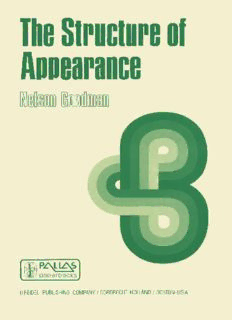
The Structure of Appearance PDF
Preview The Structure of Appearance
BOSTON STUDIES IN THE PHILOSOPHY OF SCIENCE VOLUME LIII THE STRUCTURE OF APPEARANCE SYNTHESE LIBRARY MONOGRAPHS ON EPISTEMOLOGY, LOGIC, METHODOLOGY, PHILOSOPHY OF SCIENCE, SOCIOLOGY OF SCIENCE AND OF KNOWLEDGE, AND ON THE MATHEMA TICAL METHODS OF SOCIAL AND BEHAVIORAL SCIENCES Managing Editor: JAAKKO HINTIKKA,Academy of Finland and Stanford University Editors: ROBERT S. COHEN,Boston University DONALD DAVIDSON, University of Chicago GABRIEL NUCHELMANS, University of Leyden WESLEY C. SALMON, University ofA rizona VOLUME 107 BOSTON STUDIES IN THE PHILOSOPHY OF SCIENCE EDITED BY ROBERT S. COHEN AND MARX W. WARTOFSKY VOLUME LIII NELSON GOODMAN THE STRUCTURE OF APPEARANCE Third Edition with an Introduction by GEOFFREY HELLMAN D. REIDEL PUBLISHING COMPANY DORDRECHT-HOLLAND / BOSTON-U.S.A. Library of Congress Cataloging in Publication Data Goodman, Nelson. The structure of appearance. (Boston studies in the philosophy of science; v. 53) (Synthese Library; v. 107) Bibliography: p. Includes index. 1. Phenomenology. 2. Structuralism. 3. System theory. 4. Science-Philosophy. I. Title. II. Series. Q174.B67 vol. 53 [B829.5) SOls [142'.7) 77-24191 ISBN-13: 978-90-277-0774-1 e-ISBN-13: 978-94-010-1184-6 DOl: 10.1007/978-94-010-1184-6 Published by D. Reidel Publishing Company, P.O. Box 17, Dordrecht, Holland Sold and distributed in the U.S.A., Canada, and Mexico by D. Reidel Publishmg Company, Inc. Lincoln Building, 160 Old Derby Street, Hingham, Mass. 02043, U.S.A. All Rights Reserved Copyright © 1951 by the President and Fellows of Harvard College Second Edition copyright © 1966 by the Bobbs-Merrill Company, Inc. Third edition with the Introduction by Geoffrey Hellman copyright © 1977 by D. Reidel Publishing Company, Dordrecht, Holland Softcover reprint ofthe hardcover 3rd edition 1977 No part of the material protected by this copyright notice may be reproduced or utilized in any form or by any means, electronic or mechanical, including photocopying, recording or by any informational storage and retrieval system, without written permission from the copyright owner To my father HENRY L. GOODMAN 1874-1941 EDITORIAL PREFACE With this third edition of Nelson Goodman's The Structure of Appear ance, we are pleased to make available once more one of the most in fluential and important works in the philosophy of our times. Professor Geoffrey Hellman's introduction gives a sustained analysis and appreciation of the major themes and the thrust of the book, as well as an account of the ways in which many of Goodman's problems and projects have been picked up and developed by others. Hellman also suggests how The Structure of Appearance introduces issues which Goodman later continues in his essays and in the Languages of Art. There remains the task of understanding Good man's project as a whole; to see the deep continuities of his thought, as it ranges from logic to epistemology, to science and art; to see it therefore as a complex yet coherent theory of human cognition and practice. What we can only hope to suggest, in this note, is the b.road Significance of Goodman's apparently technical work for philosophers, scientists and humanists. One may say of Nelson Goodman that his bite is worse than his bark. Behind what appears as a cool and methodical analysis of the conditions of the construction of systems, there lurks a radical and disturbing thesis: that the world is, in itself, no more one way than another, nor are we. It depends on the ways in which we take it, and on what we do. What we do, as human beings, is talk and think, make, act and interact. In effect, we construct our worlds by construing them, this way or that. The conditions on the construc tion of symbol systems are, by extension and interpretation, conditions on our construction of worlds, and of ourselves as part of the ways 'the world' is. It would be impertinent and impetuous to impose on Goodman any grand philosophical programs. He is the model of deflationary analysis, both in his methodological nominalism and in his ontological relativism. Yet the Good manian bite is infectious, and suggests a much broader program than it is his style to admit. One form of rabid Goodmania would suggest a sort of dynamic and pluralistic Kantianism, in which a prioris are as plentiful as blackberries. Serious choices among them, however, are not. As Poincare once put it, though, "Conventions, yes - arbitrary, no" 1. The empirical - one may say, objective - pull of Goodman's constructionism is that, historically and cul- Science and Hypotheses, in The Foundations of Science (New York, 1929), p. 106. I VIII EDITORIAL PREFACE turally speaking, we have chosen certain crucial constructions as more canonical than others. Goodman's argument is that it is open to us to discover, choose, invent others, because the constraints we imagine to be imposed on our choices are open to revision. By us. Center for the Philosophy and History ofS cience, ROBERT S. COHEN Boston University MARX W. WAR TOFSKY May 1977 TABLE OF CONTENTS EDITORIAL PREFACE VII FOREWORD TO THIS EDITION XIII FOREWORD TO THE SECOND EDITION XV FOREWORD TO THE FIRST EDITION XVII INTRODUCTION BY GEOFFREY HELLMAN XIX ORIGINAL INTRODUCTION XLIX PART ONE / ON THE THEORY OF SYSTEMS I. Constructional Definition 1. Extensional Identity 3 2. Substitution Criteria 7 3. Extensional Isomorphism 10 4. Consequences of Isomorphism as a Criterion 17 5. On Systems of Predicates of Individuals 22 II. The General Apparatus 1. General Apparatus and Special Basis 24 2. The Question of Classes 24 3. Nominalism 26 4. The Calculus of Individuals 33 5. The Calculus in Systems 40 III. lIxtralogicalllases 1. The Nature of Primitive Terms 45 2. The Choice of Basis 46 3. Simplicity 47 4. Reflexitivity and Complexity 54 5. Transitivity, Self-completeness, and Complexity 60 6. Symmetry and Complexity 63 7. Final Formulae for Primary Complexity 68 8. Secondary Complexity 75
Description: